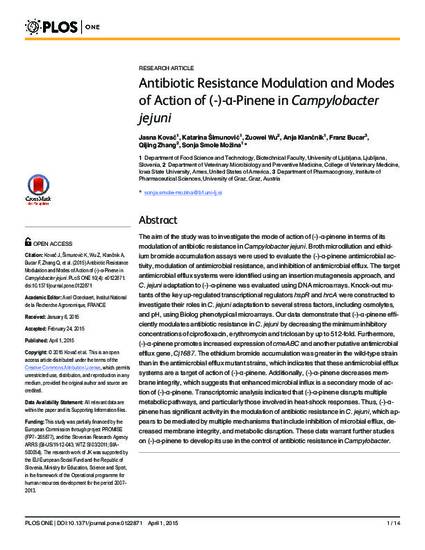
Article
Antibiotic Resistance Modulation and Modes of Action of (-)-α-Pinene in Campylobacter jejuni
PLoS ONE
Document Type
Article
Disciplines
Publication Version
Published Version
Publication Date
4-1-2015
DOI
10.1371/journal.pone.0122871
Abstract
The aim of the study was to investigate the mode of action of (-)-α-pinene in terms of its modulation of antibiotic resistance in Campylobacter jejuni. Broth microdilution and ethidium bromide accumulation assays were used to evaluate the (-)-α-pinene antimicrobial activity, modulation of antimicrobial resistance, and inhibition of antimicrobial efflux. The target antimicrobial efflux systems were identified using an insertion mutagenesis approach, and C.jejuni adaptation to (-)-α-pinene was evaluated using DNA microarrays. Knock-out mutants of the key up-regulated transcriptional regulators hspR and hrcA were constructed to investigate their roles in C. jejuni adaptation to several stress factors, including osmolytes, and pH, using Biolog phenotypical microarrays. Our data demonstrate that (-)-α-pinene efficiently modulates antibiotic resistance in C. jejuni by decreasing the minimum inhibitory concentrations of ciprofloxacin, erythromycin and triclosan by up to 512-fold. Furthermore, (-)-α-pinene promotes increased expression of cmeABC and another putative antimicrobial efflux gene, Cj1687. The ethidium bromide accumulation was greater in the wild-type strain than in the antimicrobial efflux mutant strains, which indicates that these antimicrobial efflux systems are a target of action of (-)-α-pinene. Additionally, (-)-α-pinene decreases membrane integrity, which suggests that enhanced microbial influx is a secondary mode of action of (-)-α-pinene. Transcriptomic analysis indicated that (-)-α-pinene disrupts multiple metabolic pathways, and particularly those involved in heat-shock responses. Thus, (-)-α-pinene has significant activity in the modulation of antibiotic resistance in C. jejuni, which appears to be mediated by multiple mechanisms that include inhibition of microbial efflux, decreased membrane integrity, and metabolic disruption. These data warrant further studies on (-)-α-pinene to develop its use in the control of antibiotic resistance in Campylobacter.
Rights
This is an open access article distributed under the terms of the Creative Commons Attribution License, which permits unrestricted use, distribution, and reproduction in any medium, provided the original author and source are credited
Copyright Owner
Kovač et al
Copyright Date
2015
Language
en
File Format
application/pdf
Citation Information
Jasna Kovač, Katarina Šimunović, Zuowei Wu, Anja Klančnik, et al.. "Antibiotic Resistance Modulation and Modes of Action of (-)-α-Pinene in Campylobacter jejuni" PLoS ONE Vol. 10 Iss. 4 (2015) p. e0122871 Available at: http://works.bepress.com/qijing-zhang/5/

This article is from PLoS ONE 10 (2015): e0122871, doi:10.1371/journal.pone.0122871. Posted with permission.